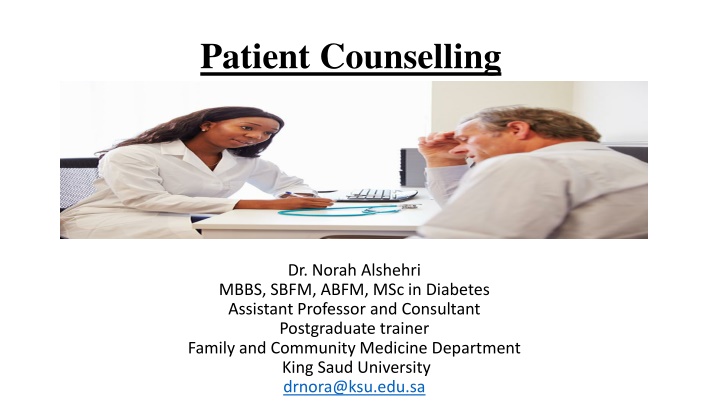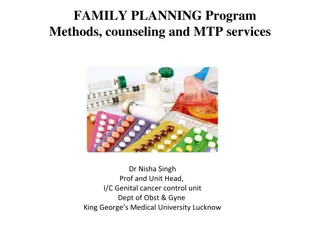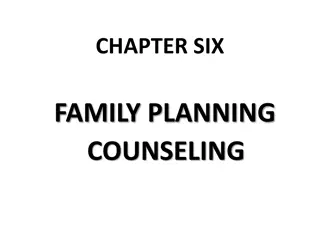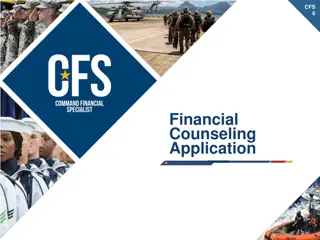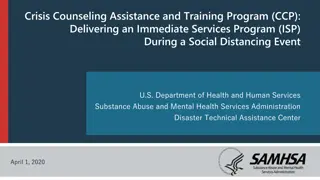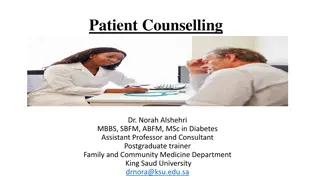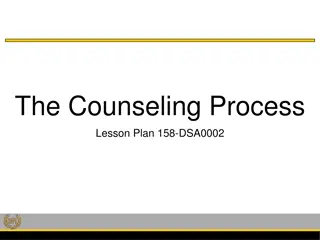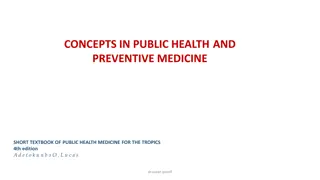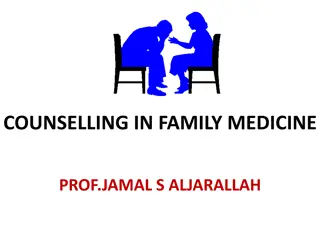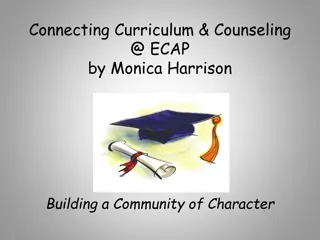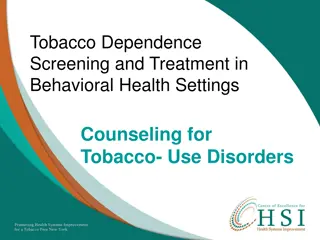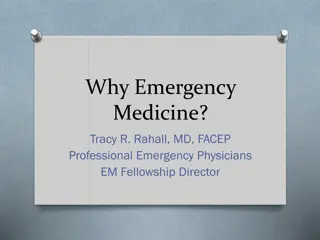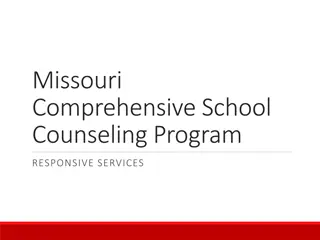Principles of Effective Counseling in Family Medicine
Understanding the concepts and importance of counseling in family medicine, learning counseling skills and stages, identifying barriers, and utilizing techniques to facilitate client well-being. Counseling aims to help clients manage problems effectively, develop coping strategies, and empower them for self-help. Key skills of a counselor include active listening, empathy, patience, non-judgmental attitude, and knowledge. A case study illustrates the importance of empathy in counseling for a patient experiencing anxiety related to work relationships.
Download Presentation

Please find below an Image/Link to download the presentation.
The content on the website is provided AS IS for your information and personal use only. It may not be sold, licensed, or shared on other websites without obtaining consent from the author.If you encounter any issues during the download, it is possible that the publisher has removed the file from their server.
You are allowed to download the files provided on this website for personal or commercial use, subject to the condition that they are used lawfully. All files are the property of their respective owners.
The content on the website is provided AS IS for your information and personal use only. It may not be sold, licensed, or shared on other websites without obtaining consent from the author.
E N D
Presentation Transcript
Patient Counselling Dr. Norah Alshehri MBBS, SBFM, ABFM, MSc in Diabetes Assistant Professor and Consultant Postgraduate trainer Family and Community Medicine Department King Saud University drnora@ksu.edu.sa
Objectives To understand the concepts of counseling in family medicine. To learn the counseling skills and why it is important. To learn the stages of counseling. To identify the possible barriers in counselling. To be able to use counseling techniques
Counselling Change cycle Stages of counselling Skills of counselor Barriers of counselling
consultation counselling communication skills
Definition Counselling is a structured conversation aimed at facilitating a client s quality of life in the face of adversity Johnson (2000, p.3) It is the skilled and principled use of relationship to help the patient develop self-knowledge, emotional acceptance and growth including personal resources.
THE AIMS OF COUNSELLING THE AIMS OF COUNSELLING The aims of Counselling should always be based on the needs of the client, which are: to help the clients manage their problems more effectively and develop unused or underused opportunities to cope more fully. to help and empower clients to become more effective self-helpers in the future (Egan,1998). Helping is about constructive change and making a substantive difference to the life of the client.
Key skills of counsellor Key skills of counsellor Listening Believing in client Recognize your own limitations. Patience Non-judgemental Stay focused Knowledgeable.
A 45-year-old lady attends the clinic regarding her symptoms of anxiety due to difficulties in her relationship with her co-workers at a school. Her examination is normal and the doctor has decided that there is no need for any investigation Which one of the following approaches by a counselor would make counseling for this patient more effective? A. Empathy during consultation* B. Giving instructions how to deal with others* C. Humor (being funny) on directing questions* D. Teaching her to stand up for her rights*
6 6 Micro skills of counsellor Micro skills of counsellor 1. Listen Actively Accept the clients as they are. Listen to what your client say and how they say it. Notice the tone of the voice ,facial expression and gesture. Keep silent sometimes. Give your client to think ,ask question. Sit comfortably. Look directly into the client when they speak ,not on your papers and windows. Ensure that you are continually involved in the conversation by either nodding head, saying then or oh
According to communication expert:- 10 % of our communication represented by words. 30 % are represented by sounds we make (by mimimum verbal) 60 % are represented by body language ( eg- eye contact , body posture etc.)
2. Questioning Ask the question to understand clearly the client problem or worries to help the client go deeper into his/her own awareness or insight. Question- centered around the concerns of client and open ended.
At the time of asking question: Remember Ask one question at a time. Look at one person Be brief and clear Ask question that serve for purpose Use question that enables clients to talk about their feelings and behaviours. Use question to explore and understand issues and not to collect juicy material for gossip. Don t ask Irrevalent question. Too many question at one time.
3.Using silence Give time to the client to think about what to say next. Provide space to experience feeling. Allows client to proceed at their own pace. Give the client freedom to choose whether or not to continue.
4. Non-verbal behavior It is not what you say but how you say is important. Majority non verbal Person body language is not similar to what they are saying, it results in verbal confusion/mis-interpretation. Effective counsellor-sensitive to nonverbal communication . Examples :-gestures, facial expression, posture, eye contact, tapping fingers, change in voice pitch and fluency of voice.
5. Accurate Empathy Empathy means- recognition and understanding of clients thoughts and emotions. It is characterized by ability to put oneself into another's shoes i.e experience the view point of another within oneself. 6. Paraphrasing Counsellor repeat in his/her own words what client has said to show understanding. Say in few words so that it can give summary of client s word.
Stages of Counselling Stages of Counselling GATHER GATHER G = Greet client in a friendly, helpful, and respectful manner. A = Ask client about needs, concerns, and previous use. T = Tell client about different options and methods. H = Help client to make decision about choice of method s/he prefers. E = Explain to client how to use the method. R = Return: Schedule and carry out return visit and follow-up of client
Greet Welcome and register client. Prepare chart/record. Determine purpose of visit. Give clients full attention. Assure the client that all information discussed will be confidential. Talk in a private place if possible.
Ask Ask client about her/his needs. Write down the client's: age, marital status, number of previous pregnancies and births, number of living children, basic medical history, previous use of family planning methods, history and risk for STDs. Assess what the client knows about family planning methods. Ask the client if there is a particular method s/he is interested in. Discuss any client concerns about risks vs. benefits of modern methods (dispel rumors and misconceptions).
Tell Tell the client about the available methods. Focus on methods that most interest the client, but briefly mention other available methods. Describe how each method works, the advantages, benefits, possible side effects, and disadvantages. Answer client concerns and questions
Help Help the client to choose a method. Repeat information if necessary. Explain any procedures or lab tests to be performed. Explain Explain how to use the method (how, when, where). Explain to the client how and when s/he can/should get resupplies of the method, if necessary.
Return At the follow-up or return visit ask the client if s/he is still using the method. If the answer is yes, ask her/him if s/he is experiencing any problems or side effects and answer her/his questions, solve any problems, if possible. If the answer is no, ask why s/he stopped using the method and counsel her/him to see if s/he would like to try another method or re-try the same method again. Make sure s/he is using the method correctly (ask her/him how s/he is using it).
Counselling and health education Counselling and health education Counselling Health education 1. Confidential Not confidential 2. One to one process or a small group. For a group of people 3. Focused, specific and goal directed Generalized 4. Facilitates change in attitude and motivates behavior change Information is provided to increase the knowledge 5. Problem oriented Content oriented 6. Based on needs of client Based on public health needs.
Cycle of changes Cycle of changes
https://www.youtube.com/watch ?v=Twlow2pXsv0
Barriers to Counseling in Clinical Practice Barriers to Counseling in Clinical Practice Personal Barriers Lack of training: undergraduate/postgraduate Undervaluing importance of communication Focus only on treating diseases Personal Limitations Organizational Barriers Lack of time Pressure of work Interruptions
Conclusion Conclusion Counselling is a process and not merely a technique through which clients are helped to modify their behavior and cope with their status effectively. Counselling is not Telling or directing Giving advice A casual concern A confession Praying
Roll play Roll play
